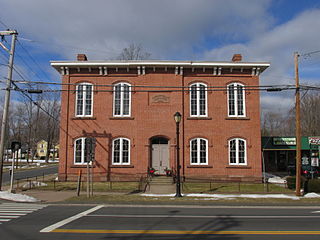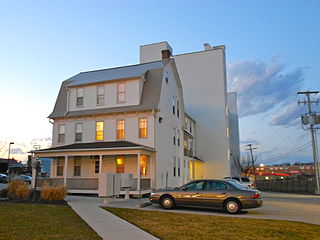
The Oregon Commercial Historic District is a historic district in Oregon, Illinois, that has been listed on the National Register of Historic Places since 2006. The district is roughly bordered by Jefferson, Franklin, 5th and 3rd Streets in Oregon. It is one of six Oregon sites listed on the National Register and one of three to be so listed since the turn of the 21st century. The other two are the Oregon Public Library, listed in 2003, and the Chana School, listed in 2005.

The South Central Falls Historic District is a historic district in Central Falls, Rhode Island. It is a predominantly residential area, densely populated, which was developed most heavily in the late 19th century. It is bounded roughly by Broad Street to the east, the Pawtucket city line to the south, Dexter Street to the west, and Rand Street and Jenks Park to the north. It has 377 contributing buildings, most of which were built before 1920. The district was added to the National Register of Historic Places in 1991.

The Hazardville Historic District is a historic district in the Hazardville section of Enfield, Connecticut, United States, that is listed on the National Register of Historic Places.

Glenville Historic District, also known as Sherwood's Bridge, is a 33.9 acres (13.7 ha) historic district in the Glenville neighborhood of the town of Greenwich, Connecticut. It is the "most comprehensive example of a New England mill village within the Town of Greenwich". It "is also historically significant as one of the town's major staging areas of immigrants, predominantly Irish in the 19th century and Polish in the 20th century" and remains "the primary settlement of Poles in the town". Further, "[t]he district is architecturally significant because it contains two elaborate examples of mill construction, designed in the Romanesque Revival and a transitional Stick-style/Queen Anne; an excellent example of a Georgian Revival school; and notable examples of domestic and commercial architecture, including a Queen Anne mansion and an Italianate store building."

The East Jefferson Avenue Residential District in Detroit, Michigan, includes the Thematic Resource (TR) in the multiple property submission to the National Register of Historic Places which was approved on October 9, 1985. The structures are single-family and multiple-unit residential buildings with construction dates spanning nearly a century, from 1835 to 1931. The area is located on the lower east side of the city.

Washington Avenue Historic District is the historic center of Cedarburg, Wisconsin, the location of the early industry and commerce that was key to the community's development. The historic district was listed on the National Register of Historic Places (NRHP) in 1986.

There are nine historic districts in Meridian, Mississippi. Each of these districts is listed on the National Register of Historic Places. One district, Meridian Downtown Historic District, is a combination of two older districts, Meridian Urban Center Historic District and Union Station Historic District. Many architectural styles are present in the districts, most from the late 19th century and early 20th century, including Queen Anne, Colonial Revival, Italianate, Art Deco, Late Victorian, and Bungalow.

Grace Episcopal Church Complex is a historic Episcopal church complex located at Lyons in Wayne County, New York. The complex consists of a contributing stone church building begun in 1838, a contributing frame rectory begun about 1833, and a contributing parish house built in 1887–1888. The church building is Gothic Revival in style and constructed of rubble limestone walls with cut limestone trim. The rectory is an irregularly massed two story, wood-frame building incorporating a former private residence built at this site about 1833 in the vernacular late Federal / early Greek Revival style. The parish house is a single story, frame building designed in the Queen Anne style.

College Square Historic District is a nationally recognized historic district located on a bluff north of downtown Davenport, Iowa, United States. It was listed on the National Register of Historic Places in 1983. The district derives it name from two different colleges that were located here in the 19th century.
In the United States, the National Register of Historic Places classifies its listings by various types of architecture. Listed properties often are given one or more of 40 standard architectural style classifications that appear in the National Register Information System (NRIS) database. Other properties are given a custom architectural description with "vernacular" or other qualifiers, and others have no style classification. Many National Register-listed properties do not fit into the several categories listed here, or they fit into more specialized subcategories.
The Carriage House Historic District in Miles City, Montana was added to the National Register of Historic Places in 1991. The historic district contained 54 contributing buildings and 21 non-contributing ones, on the 900 to 1100 blocks of Pleasant and Palmer Avenues and on cross streets. Nine locations feature signs describing the property.

West Side Sanitarium, also known as West Side Osteopathic Hospital, is a historic sanitarium complex located at West York, York County, Pennsylvania. The complex consists of four buildings: two large medical buildings and two residences. The Sanitarium was originally built as a hotel in 1905, and doubled in size in 1924, with an addition and rear ell. It is a 3+1⁄2-story, Dutch Colonial Revival-style brick-and-frame building with a gambrel roof. It measures approximately 110 feet wide and 31 feet deep. The Nurses' Home and Sanitarium Annex was built in 1924, also in the Dutch Colonial Revival-style. It is a 3+1⁄2-story, 28-foot-wide by 30-foot-deep, frame building, expanded in 1931, with a 4-story rear addition measuring 25 feet wide by 34 feet deep. It features a one-story full-width porch with Tuscan order columns. The Doctors' Home and Dr. Meisenhelder's Home and Office were built in 1905, and are in a vernacular Queen Anne style. They are 2+1⁄2 stories tall with cross-gabled, slate-covered roofs and each measure about 20 feet wide by 40 feet deep. Three of the four buildings are connected via tunnels. The hospital remained in operation until 1962, after which the buildings housed a business college then home to the Aquarian Church of Universal Service.
St. Scholastica Catholic Church is a historic church building on the west side of Fourth St., between Wisconsin and State Streets in Letcher, South Dakota. The St. Scholastica Rectory is its rectory. The two buildings were separately listed on the National Register of Historic Places in 1994.

The Porter–Vallejo Mansion, located at 29 Bishop St. in Pajaro, California, is a historic Queen Anne style house that was designed by architect William Henry Weeks. It is listed on the National Register of Historic Places.

Blackstone Historic District is a national historic district located at Blackstone, Nottoway County, Virginia. It encompasses 272 contributing buildings and 1 contributing structure in the town of Blackstone. They include residential and commercial structures dating from the late-18th to early-20th centuries. They include notable examples of the Late Gothic Revival, Queen Anne, and Romanesque styles. Notable buildings include the former Blackstone College for Girls (1922), First National Bank, Thomas M. Dillard House, Richmond F. Dillard House, Blackstone Public School Complex, Bagley House (1911), James D. Crawley House (1903), Blackstone Baptist Church (1907), Crenshaw United Methodist Church (1903), St. Luke's Episcopal Church (1916), and Blackstone Presbyterian Church (1901). The James D. Crawley House was designed by J. E. McDaniel, who was a local architect. Located in the district is the separately listed Schwartz Tavern.

Elmwood Historic District–West is a national historic district located at Buffalo, Erie County, New York. The district encompasses 1,971 contributing buildings, 4 contributing structures, and 13 contributing objects in the Elmwood Village neighborhood of Buffalo. It is built around the Buffalo Parks and Parkways system bounded on the north by Delaware Park, Forest Lawn Cemetery, and the former Buffalo State Asylum, on the south by the Allentown Historic District, and on the east by the Elmwood Historic District–East. This predominantly residential district developed between about 1867 and 1941, and includes notable examples of Queen Anne, Shingle Style, Colonial Revival, Tudor Revival, and American Craftsman style architecture. The district contains one of the most intact collections of built resources from turn of the 20th century in the city of Buffalo and western New York State. Located in the district are six previously listed contributing resources including the Richmond Avenue Methodist-Episcopal Church and the Buffalo Tennis and Squash Club. Other notable building include the H.C. Gerber House (1908), the Fred Dullard House (1910), the William H. Scott House (1904), St. John's-Grace Episcopal Church designed by Bertram Grosvenor Goodhue (1925–26), Davidson House (1885), former Jehle Grocery Store and Residence, St. Luke's Episcopal Church, Temple Beth El, Richmond Avenue Church of Christ (now Bryant Parish Condominiums, and Pilgrim-St. Luke's United Church of Christ.

The Gorham Campus Historic District encompasses seven buildings that make up the historic heart of the campus of the University of Southern Maine in Gorham, Maine. Built between 1806 and 1931, they reflect the varied academic history of the campus, and were listed on the National Register of Historic Places in 1978.

The Park-to-Park Residential Historic District in Fort Madison, Iowa, United States, was listed on the National Register of Historic Places in 2014. The historic district is located to the north of the Downtown Commercial Historic District, generally between Central Park on the west and Old Settler's Park on the east. Both parks are contributing sites. For the most part the district is made up of single family homes built in the late 19th and early 20th centuries. Some of these homes were built as rental properties, while others became so in later years. The Albright House and the Chief Justice Joseph M. Beck House are contributing properties, and they are also individually listed on the National Register. There are also duplexes and a few small scale apartment buildings in the district.

The Putney Village Historic District encompasses most of the main village and town center of Putney, Vermont. Settled in the 1760s, the village saw its major growth in the late 18th and early 19th century, and includes a cohesive collection with Federal and Greek Revival buildings, with a more modest number of important later additions, including the Italianate town hall. The district was listed on the National Register of Historic Places in 1986.

The Center Avenue Neighborhood Residential District is a residential historic district located in Bay City, Michigan, running primarily along Center, Fifth, and Sixth Avenues between Monroe and Green Avenues, with additional portions of the district along Fourth between Madison and Johnson, down to Tenth Avenue between Madison and Lincoln, along Green to Ridge, and around Carroll Park. The original section, along Center and portions of Fifth and Sixth, was listed on the National Register of Historic Places in 1982. A boundary increase including the other sections of the neighborhood was listed in 2012.

















